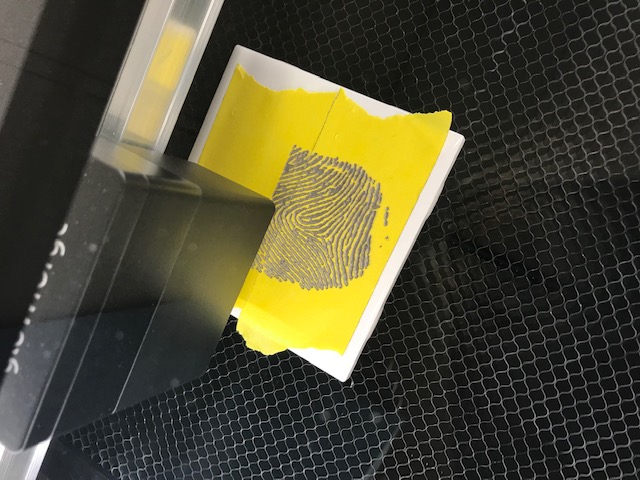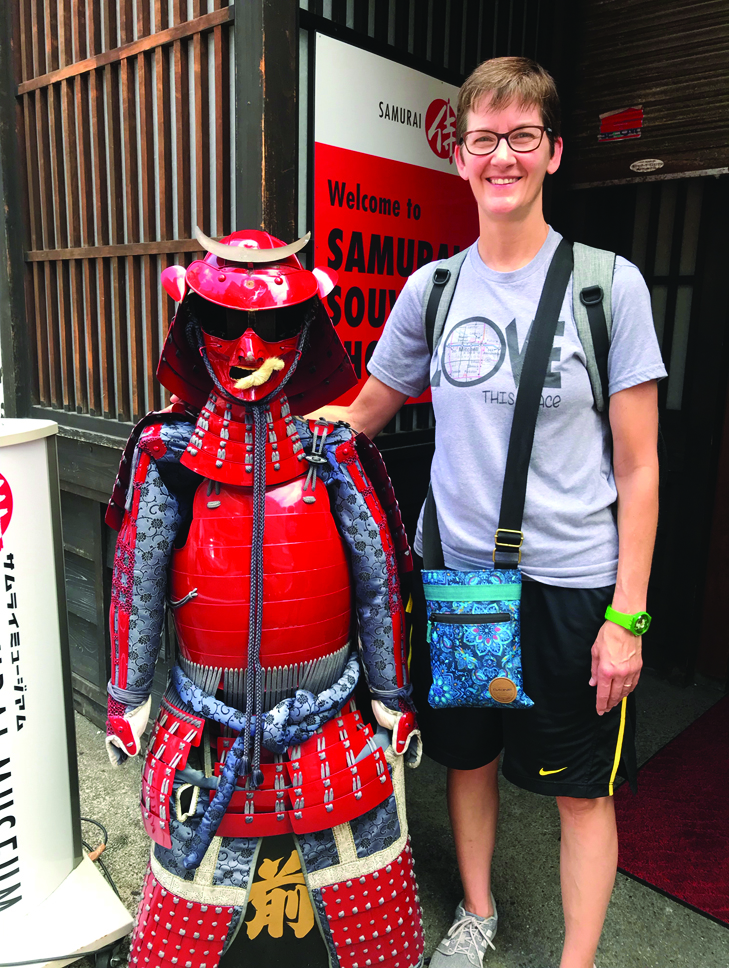Teacher Spotlight
Julie Olson, Mitchell, South Dakota
An Interview with Julie Olson, Mitchell, South Dakota
Julie at the Samurai museum in Tokyo as part of the Fulbright Japan ESD program.
Describe your school and classes.
Mitchell High School is a small, rural high school (750 students in grades 9–12). Our main civic attraction is the Corn Palace (our school mascot is an ear of corn with the name Cornelius.) We even have a radio station with the call letters KORN. The school offers a variety of common classes as well as dual-credit, online, and CTE (career and technical education—engineering, agriculture, biomedical, building trades, welding, and photography). We also have an alternative school for at-risk students, which offers a self-paced, customized program.
In the mornings, I teach science for Second Chance HS (our alternative school). I have between 10 and 18 students at a time, each on a different course in a different spot at the same time. This may seem chaotic, but the one-on-one with small units making up the courses allows me to discuss, explain, and problem solve in a short amount of time.
The required courses (Physical Science, Biology, and Chemistry) utilize the online Edgenuity platform. I have gone through each of the courses and chosen hands-on activities for students. I have developed a variety of elective courses to introduce career opportunities as well as spark interest: Basic Electronics, Robotics, Drones, Forensics, Applied Biochemistry (drug, nicotine, and alcohol education), and Anatomy. We also offer Environmental Science (a blended online and hands-on course).
About twice a month, we conduct classwide experiments and projects, ranging from testing the water quality of the local lake, making cardboard box pizza ovens, studying the chemistry of pottery and glazes, and even basic CAD to do 3D printing or laser cutting/engraving. We have also entered into a partnership with the culinary teacher to build and maintain a hydroponic system. A variety of herbs, onions, lettuce, and spinach are used by the culinary class (of which several of our students are also a part).

Laser etching a fingerprint into a tile as part of a CSI unit.
With the flexibility of the students’ schedules, small staff, and central location of our approximately 80 students, it is easy to schedule collaborations with the other teachers as well as engage many of our students in larger projects (e.g., stocking our classroom-raised trout through the Trout in the Classroom project) or community service projects (e.g., planting at the community garden, water testing).
I can also tailor electives and special projects to the students’ individual likes/needs more easily than in a large standard class. As an example, a physical science student who was also a very good artist built replicas of DaVinci’s inventions and studied Alexander Calder and his kinetic mobiles. He then built a mobile based on his own hobbies and interests.
In the afternoons, I teach Bio-151, which is a dual-credit course with the Northern State University Rising Scholars Program. Students in the course can sign up for college credit if they choose. This course covers required biology concepts for the college course but also includes a great deal of anatomy and student research opportunities. This is a “traditional” style class with lectures and group labs/activities at the same pace.
Offering students a variety of unique opportunities and exposing them to a wide range of biology areas is one of my main goals. Students start by researching and testing common plants for their antimicrobial properties. When studying muscle physiology, they test human-to-human interface systems and get to “control each other’s muscles/movements.” In the spring, biomechanics and computers come together as they create cyborg cockroaches. The advantage of this style of class is the ability to set up complex labs and research. When certain lab activities are set up, I can also offer them to the alternative school students.
After school and on weekends, one will find me mentoring students for the science and engineering fair or helping Second Chance students lead Science Saturday activities for elementary students. Our most recent Saturday had 35 wizard scientists making troll bogies (slime), potions (red cabbage juice and pH), and practicing levitation (paper airplanes).

Weeknights, one may find me either announcing for the high school volleyball team or teaching a Secondary Biology Methods course for the local university (Dakota Wesleyan University).
What are some of the resources you use for ideas and inspiration?
Professional associations are very important. The communication and conferences provide lots of ideas. I attend workshops as well as our state science conference every year. I am a member of both NSTA and NABT. The Science Teacher and NSTA Reports always list many opportunities to engage in professional development (PD).
I get many ideas from the periodicals and have found that the ability to look at back issues is very helpful. As an example, I wanted to incorporate engineering into my cardiovascular unit, so I found and modified an activity from a back issue of TST. I modify many older activities to align with the NGSS. As the co-editor of the South Dakota Science Teachers Association (SDSTA), I am always looking for PD opportunities to share. I have found that applying for PD and committees, as well as participating on email lists leads to getting more announcements and opportunities. With the common lunch times of the Second Chance and CTE staff, we collaborate quite frequently. My sister is an art teacher, so we collaborate a lot on activities.
One cannot be afraid to apply for committees or programs such as NCTM/NSTA STEM Ambassador program or Innovation Collaborative. Teachers are not comfortable acknowledging their ability to contribute so we don’t automatically apply to be on committees or study groups. I was fortunate to be chosen to be on both the NGSS as well as South Dakota science standards writing teams. Getting to work with other committed individuals is very inspiring. I have learned not only how to promote STEM and STEAM but also exchange and collaborate with these inspiring individuals. I recently was part of the Fulbright Japan ESD program and am still collaborating with both the American and Japanese teachers on projects.
Talk about your teaching methods. In what ways do you encourage innovative thinking in your classes? How do you keep everyone engaged?
I love doing hands-on activities that give students a choice—be it materials, procedure, or design. There are some prescribed labs, but these are to develop skills and knowledge that they will be able to adapt and use for more open-ended activities later in a unit. Some of the best lessons are those where they start to question themselves such as “Which is better? To dip a chip then flip it over to dip again? Or to double dip?” (when we start taking about bacteria). Or, when starting the musculo-skeletal system I tell them that I can’t do push-ups because my arms are too long. Is there evidence they can gather to prove me wrong?
With the vast array of materials and technology present in the room, if a student expresses a need, I can usually supply a possible method (e.g., 3D print, robot, laser) or materials they could use. We conclude the year with a two-week crime scene. I set up a scene complete with evidence that all teams come examine for sketching, tagging, and photographing. Then they analyze, ask questions (interrogations), look for patterns, come to conclusions, and write a scenario based on their evidence.
I have the alternative school students try 3D printing and laser cutting (Bio-151 students are always welcome to come in out-of-class time to further investigate and use these machines), preferably of their own design, but have found that they need to see the capabilities first. Elective courses are designed around many of their interests, both career and personal.
Constructing a cribbage board using CAD software and the laser cutter.
I will sometimes team up a reluctant student with some others on a project. With the flexibility of our system, I can design alternative activities geared to the student(s) pretty easily, limited only by the availability of materials and technology at hand. I have applied and received many grants over the years to be able to provide a variety of opportunities and materials for my students (about $200,000).
How much do you have to stand behind your students as they’re doing their projects?
When students see a purpose and have the necessary skills, my job is to provide the problem they have to solve or the question they have to attempt to answer, make them aware of safety and ethical concerns, and provide the materials (or at least some of them). If they run into problems, sometimes it is as easy as pointing them to a source or asking a simple question—or brainstorming with them, while letting them know I have confidence in them to do this. One also has to realize that there is merit to some projects that divert from my intended path. My job then is to support and guide them as needed.
What’s the one project that you’ve always wanted to do but have never been able to, due to lack of time, money, etc.
I have two projects that I would like to do. One is designing a course around the book The Martian (classroom edition). I have read the book several times and have notes on many activities that apply to the situations from the book. I just haven’t had the time to not only assemble all of the activities but to design the criteria and materials. I would like to make this self-paced, which means that the materials have to be ready at any time a student is taking that course (just like all of our other alternative school courses, required and elective.)
Another project would be utilizing the 3D printers, electronics, laser cutter, and Vernier sensors to design a course around music. I had a student 3D print woodwind reeds from various filaments, play notes, and digitally analyze the quality of sound (alternative school student for a science fair project). I also had some alternative school students build amplifiers (as part of their electronics course) then build single-string Bo Diddley electric guitars. It would be fun to have my students work with elementary students to build guitars for their music program as well as explain the science behind the music.
What do you feel is the most important big picture takeaway for your students? If nothing else, what one thing do you want them to learn?
The most important takeaway is that science applies to everything they do. I want them to learn how to search for and analyze the evidence and make sound decisions based on evidence—be it in a lab, the grocery store, their homes, and as citizens. I want them to have confidence in themselves to not only answer but ask questions and to solve problems.
On the Web
Edgenuity: www.edgenuity.com/
Careers Teacher Preparation Teaching Strategies


